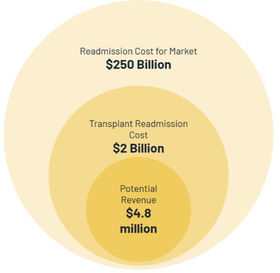Live Fully: A Subscription Based Service to Support Liver Transplant Recipients
Cate Tompkins, Hyemin Bae, and Anirban Ghosh

Liver transplantation is necessary when individuals go into liver failure; individuals who receive transplants are very ill prior to transplantation.
The 10-year post-transplant survival rate is 59.4%,3 which implies that effectively 40.6% of the patients with a successful operation pass away within the 10 years post-transplant.

Through our service, we aim to target the three pain points identified (marked in blue) and address them with different products and services.

Post-acute hospitalization care is a widely underserved area of healthcare. In a single-center study, 46% of liver transplant recipients were readmitted to the hospital within 90 days of surgery. These hospital readmissions are costly (an average of $43,785 per person) and are associated with decreased long-term graft and patient survival.
When interviewing transplant patients, caregiver, and clinicians, we realized post-transplant life is very complicated. Adherence to post-transplant medication, frequent laboratory testing and clinic visits, dietary changes, lifestyle adjustments, and positive psychosocial well-being are all critical factors to successful transplant outcomes.
-
Post-hospitalization treatment is even more complicated
-
No standardized post-care and information resources
-
The success of the recipients' follow-up care depends on the initiative of the recipient and caregiver
-
Online support groups and nonprofit organizations give immense support
-
Not many have full-time caregivers

Goals of the product

The package includes a set of digital tools (app and website) which includes:
1. A Patient Journal: A central place to log activities, medication, medication changes, side effect tracking, and chat room logs.
2. Health Tracking: Track health parameters in a centralized place and see trends of things like blood glucose, heart rate, blood pressure, temperature, and upcoming appointments.
3. A digital community: For recipients to come together and build a sense of community.
4. Medication Tracking: to track medication with timely reminders on when and how to take medication.
5. Meal Plan: A dynamically generated set of recipes based on user preferences, medication restrictions, and restrictions because of the accompanying co-morbidities.
Value to Users
The Recipient: The “Live Fully” service provides a toolkit to its users to live a life less burdened by the transplant. The service aims to help ease the transition into post-transplant life.
The Caregiver: Caregivers play a vital role in the first few weeks after the transplant. Having all the information present in a clear manner helps them navigate the role more effectively
.
Value to Payer
The Hospital: Hospitals are incentivized to reduce readmissions because of the Medicare payment bundle and value-based care incentives. The service helps reduce readmission costs they incur & boosts their quality score.
The Insurance Companies: Helping the user transition into a healthier and safer lifestyle reduces chances of readmissions and the expenditures associated with the same.

We realized early on that the journey of each and every user is different and their needs and wants change with time and our pricing and service should reflect the same.

Market Size
The transplant population is small, and it is easier to acquire users in that space, making it the perfect beachhead market. This market has a value of $48 million.
Considering the smaller number of patients and the closeness of the community, we believe that it would be possible to capture 10% to 20% of this niche market by leveraging network effects. This revenue is only the beginning.
Transplant patients represent annual readmission costs of about $2.2 billion. This is a small percentage compared to the readmission costs of $250 billion for all major surgeries. The generated revenue is only a tiny fraction of the total costs associated with readmissions.
New CPT Codes for Reimbursement
In designing our service, we focused on incorporating products that could provide clinically relevant outcomes for which insurance companies may feasibly consider providing coverage. For example, we discovered that many Medicare Advantage insurance plans already cover up to $5,000 in travel and lodging in the transplant payment bundle, as well as provide incentives for individuals to live a healthy lifestyle (BlueCross BlueShield; Vitality).
Due to rising demand for remote care, new CPT codes have been released, which offer on average $50 per user/month. The $50 reimbursement can save the payer many multiples of the payout.








